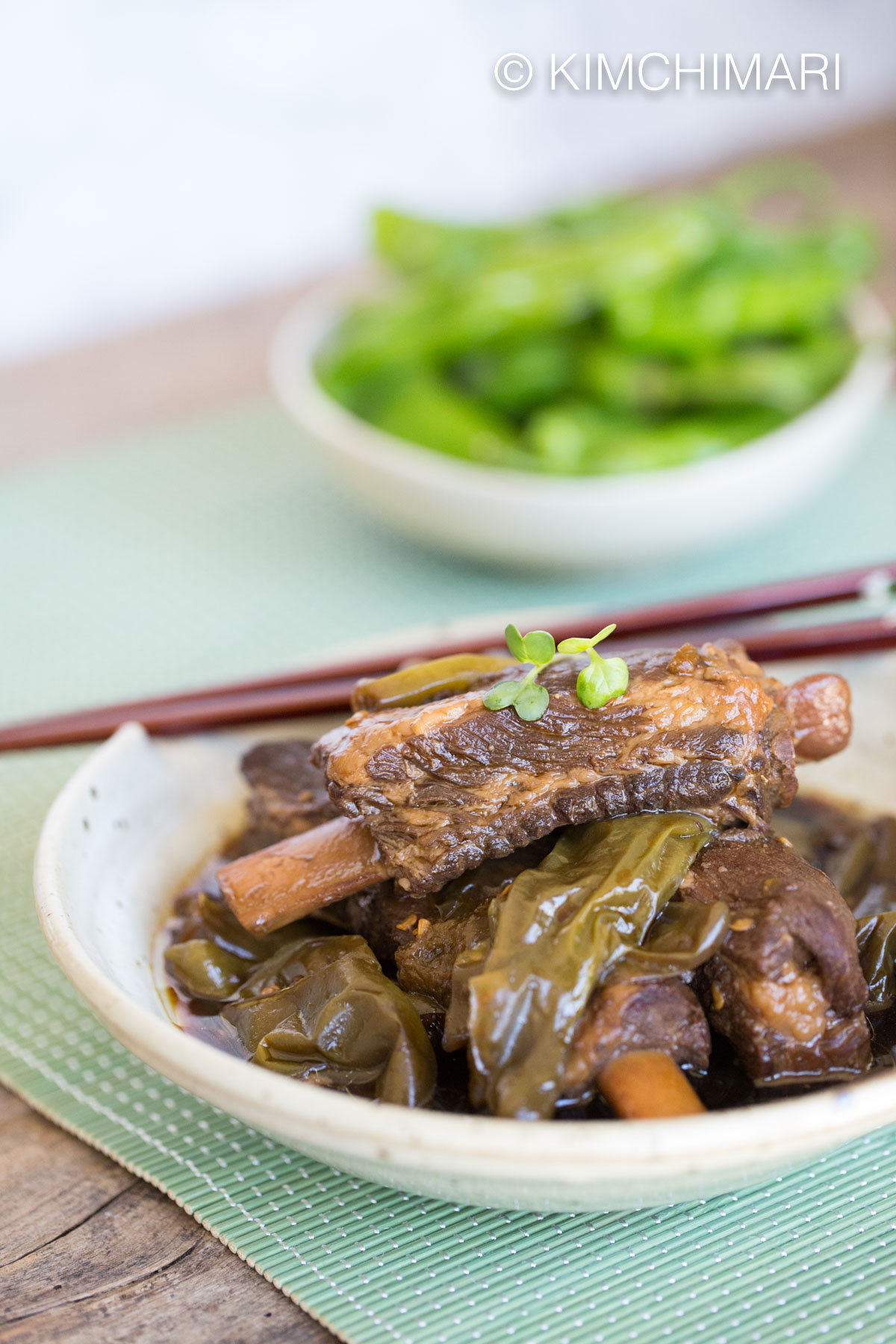
Spicy Soy Pork Ribs with Shishito Peppers or simply Dwaeji Galbi Jjim 돼지갈비찜 in Korean. Ready in 30 minutes in your Instant Pot!
Spicy Soy Pork Ribs with Shishito Peppers or Dwaeji Galbi Jjim is the latest recipe that I developed for the Instant Pot. I used a lot of shishito peppers because our family have really fell in LOVE with these peppers lately (especially my daughter) and they are in full season right now.
In Korean, we call Shishito Peppers, Kkwari Gochu 꽈리고추. The flavor of this pepper is very mild with almost no heat and yet there’s still that hint of lovely peppery spiciness with a slight sweetness that makes these peppers so addicting. The skin is also thinner and more tender. The other day, I just stir fried it with a little bit of oil and some of my apple lemon soy sauce and it came out really delicious.
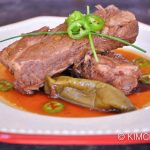
A note about its Korean name and Jorim vs Jjim:
Back in 2011, I posted Spicy Soy Braised Pork Ribs with chili peppers and called it Spicy Soy Braised Pork Ribs or Dwaeji Galbi Jorim because that’s what we called it in our family. Many Koreans use the words Jorim 조림 and Jjim 찜 without a lot of distinction and I am certainly guilty of that (as in my post in 2011). However, I feel I need to make a little correction before we go further. Let’s look at the difference of Jorim vs Jjim in more detail.
According to the International Korean Menu Guide (published by Korean Food Foundation) in 2012:
Jjim is called Braised Dishes and defined as “dishes made by slowly braising or steaming seasoned meat, seafood or vegetables in a sauce”.
Jorim is called Glazed Dishes and defined as “meat, fish and vegetables seasoned and simmered over a low flame until sauce is reduced to a glaze”.
According to Wikipedia:
Jjim (찜; Korean pronunciation: [tɕ͈im]) is a Korean cuisine term referring to dishes made by steaming or boiling meat, chicken, fish, or shellfish which have been marinated in a sauce or soup. (source wikipedia)
Jorim (조림) is a simmered Korean dish, made by boiling vegetables, meat, fish, seafood, or tofu in seasoned broth until the liquid is absorbed into the ingredients and reduced down. (source wikipedia)
In my opinion, both of these definitions are not completely correct. Mainly I have 2 issues with these definitions. I know I have used the term Braise to refer to Jjim dishes in the past but I realized after my culinary techniques class that this is not completely correct. The term Braising is a mixed cooking technique of dry heat (searing in pan) and wet heat (boiling with liquid) but in Korean Jjim, meats are never seared before they are cooked in liquid so it’s missing the dry heat part of braising.
Thus, Braising ≠ Jjim.
2nd issue is with Wikipedia defintion of Jjim. Jjim is not just simply steaming or boiling seasoned ingredients in sauce or soup but there is a “slow cooking” element to Jjim. Although the word Jjim literally means “steamed dishes”, it has come to refer to dishes that are SLOWLY boiled/simmered like Galbi Jjim, Suyuk that are cooked to perfect tenderness through the ingredient of time.
So I know this may be too much info for some of you but defining and categorizing properly is just something I like to do. 😝I should remember to include this in my future dream cookbook… haha.
Right, let’s get cooking, shall we?
BTW, in my past non-IP Dwaeji Galbi Jorim recipe, you will see that pork short ribs needs to be cooked for 75 minutes which is fine. But with my instant pot, I was able to cook my Spicy Soy Pork Ribs recipe in just 25 minutes!! And of course, it tasted just as delicious if not better – I know I am saying this for the 3rd time in a row for my Instant Pot recipes but that’s the truth. Recipe is basically the same (reduced water amount) except I added a whole bunch of Shishito Peppers (꽈리고추 Kkwari Gochu) because my daughter is in love with these lately. 😍
If you don’t have an Instant Pot, you should consider getting one. The one I have is the Instant Pot Duo 7-in-1 6 Qt. 🙂 You know that I won’t recommend it unless I really like it. They also have a new 3 qt size if you want a smaller one. Go to my store and look under Cooking Tools for a link.
Spicy Soy Pork Ribs with Shishito Peppers (Dwaeji Galbi Jjim) for IP
Servings: 6 Prep Time: 5 min Cook Time: 25 min Difficulty: Easy
Ingredients – see adjustable recipe card below
- Trim fat from ribs and cut ribs into individual pieces.
St Louis Style Ribs cut for Korean Soy Pork Ribs (Dwaeji Galbi Jjim) - Soak ribs in cold water for 10 minutes.
- Peel and cut fresh ginger into 1/4 inch thick pieces.
- Rinse chili peppers and cut each pepper into 2-3 pieces.
- Rinse shishito peppers and take off the stems but leave it whole.
Shishito peppers and Korean Green Chili peppers for Dwaeji Gallbi Jjim - In the Instant Pot, add ribs, water, soy sauce, ginger, 3-4 Korean green peppers, black pepper.
Dwaeji Galbi Jjim (spicy soy pork ribs) Instant Pot - Close the lid and set your Instant Pot to Meat/Stew function but REDUCE time to 20 minutes.
- When it is done, let off steam to open the lid. Add rest of chili peppers and all of shishito peppers.
Shishito added to Dwaeji Galbi Jjim - Close Instant Pot again, set it to manual – 5 minutes at low pressure. Open when the pressure has been released.
- One last step is to skim the fat from the finished Dwaeji Galbi Jjim as you will see quite a bit of fat that has accumulated on top.
- Serve warm! And use the warm function of IP to keep it warm.
Instant Pot Soy Pork Ribs (Dwaeji Galbi Jjim)
Ingredients
- 2 lb pork ribs (St. Louis Style)
- 195 ml soy sauce (jin ganjang 진간장 - good quality)
- 1 1/2 cup water
- 7 shishito peppers or more to taste
- 1 oz fresh ginger
- 1/8 tsp black pepper
- 3 Korean green chili peppers or Jalapeno peppers (but 30% less amount) - optional
Instructions
- Trim fat from ribs and cut into individual pieces.
- Soak ribs in cold water for 10 minutes.
- Peel and cut fresh ginger into 1/4 inch thick pieces.
- Rinse chili peppers and cut each pepper into 2-3 pieces.
- Rinse shishito peppers and take off the stems but leave them whole.
- In the Instant Pot, add ribs, water, soy sauce, ginger, 3-4 Korean green peppers, black pepper.
- Close the lid and set your Instant Pot to Meat/Stew function but REDUCE time to 20 minutes.
- When it is done, let off steam and open to add rest of chili peppers and all of shishito peppers.
- Close Instant Pot again, set it to manual 5 minutes at low pressure. And voila! You are done.
Tips & Notes:
- Optionally, add 12-16 shishito peppers for extra flavor without adding much spiciness.
- garnish with some daikon sprouts for nicer presentation.
Nutrition Information:
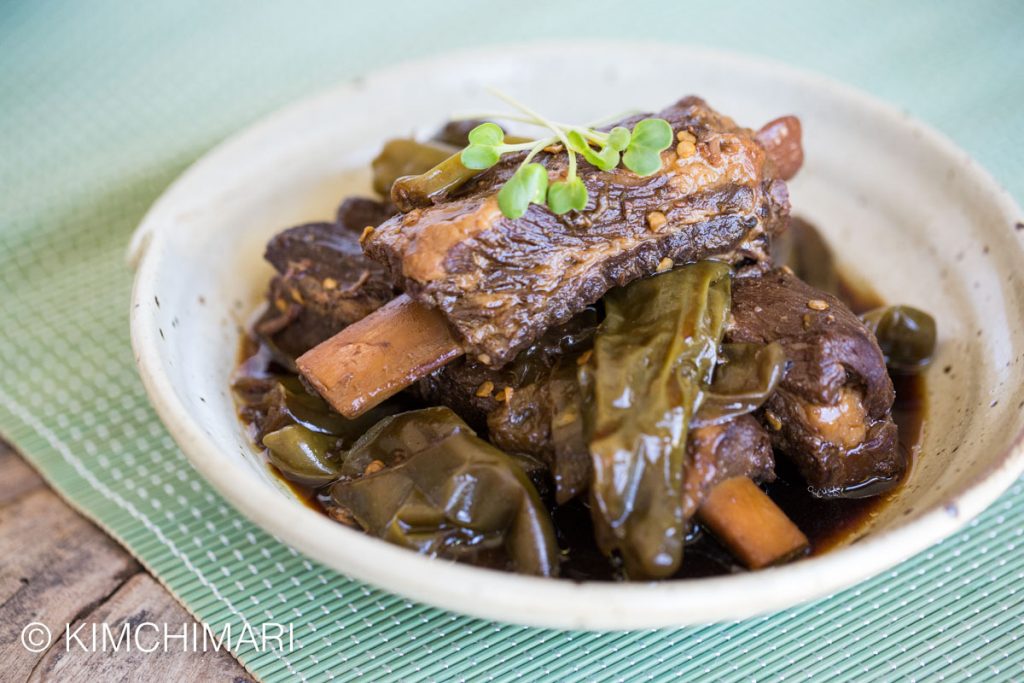
Tips
- Skimming fat from top of Spicy Soy Pork Ribs –
- method 1 – just use a spoon or ladle to skim off fat
- method 2 – let it cool in fridge until fat hardens and then take if off. See my Galbi Jjim post for details.
- method 3 – pour off all the liquid into a glass jar. fat will rise to top, keep pouring and the fat will spill over
- Serve with rice, kimchi and something creamy like a Korean kabocha salad or sauteed string potatoes with mayonnaise.
- Leftovers can be stored in fridge and reheated. Add a little water every time you reheat.
ENJOY!!
XOXO ❤
JinJoo
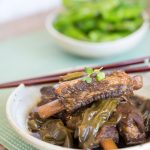
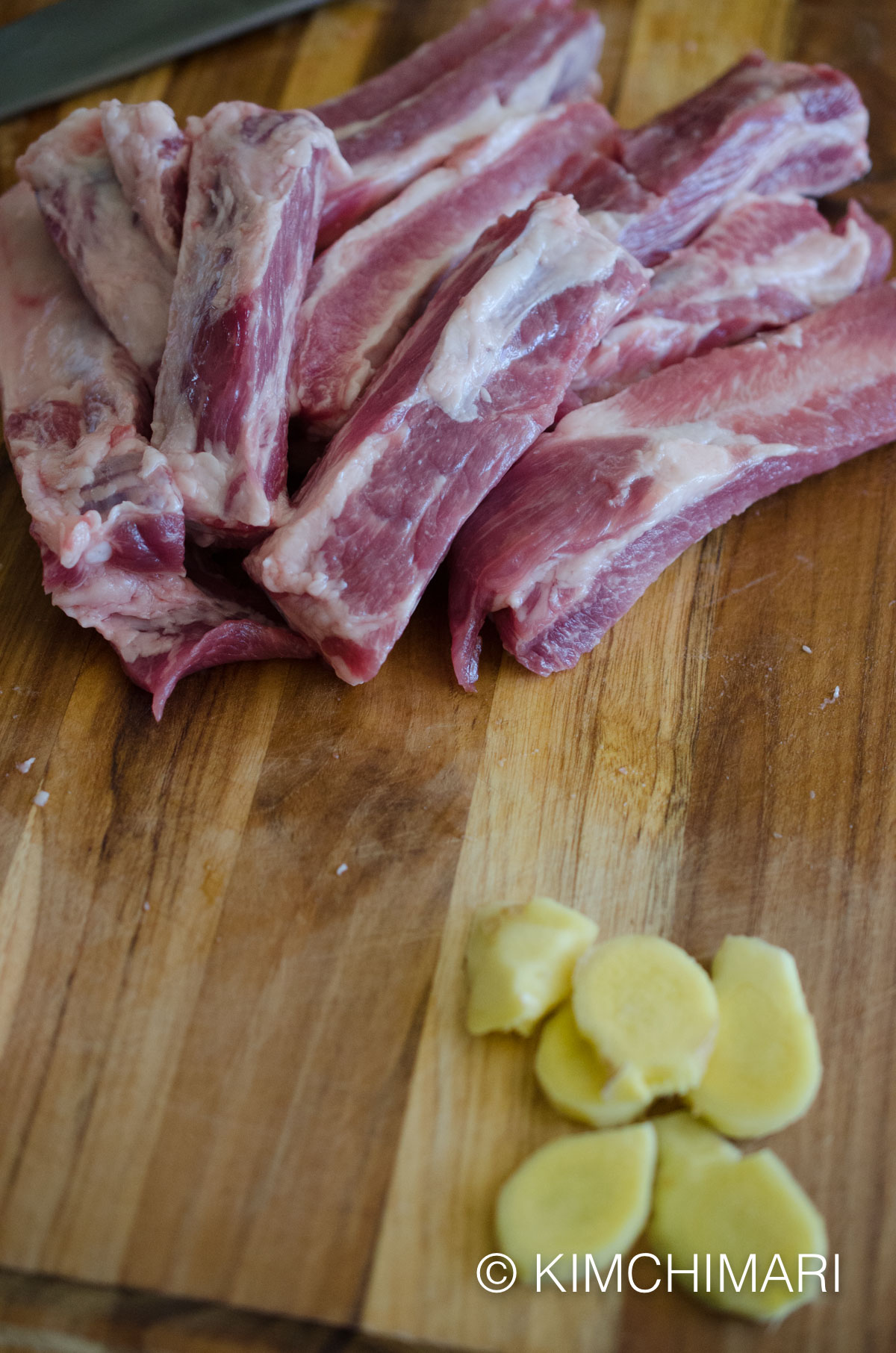


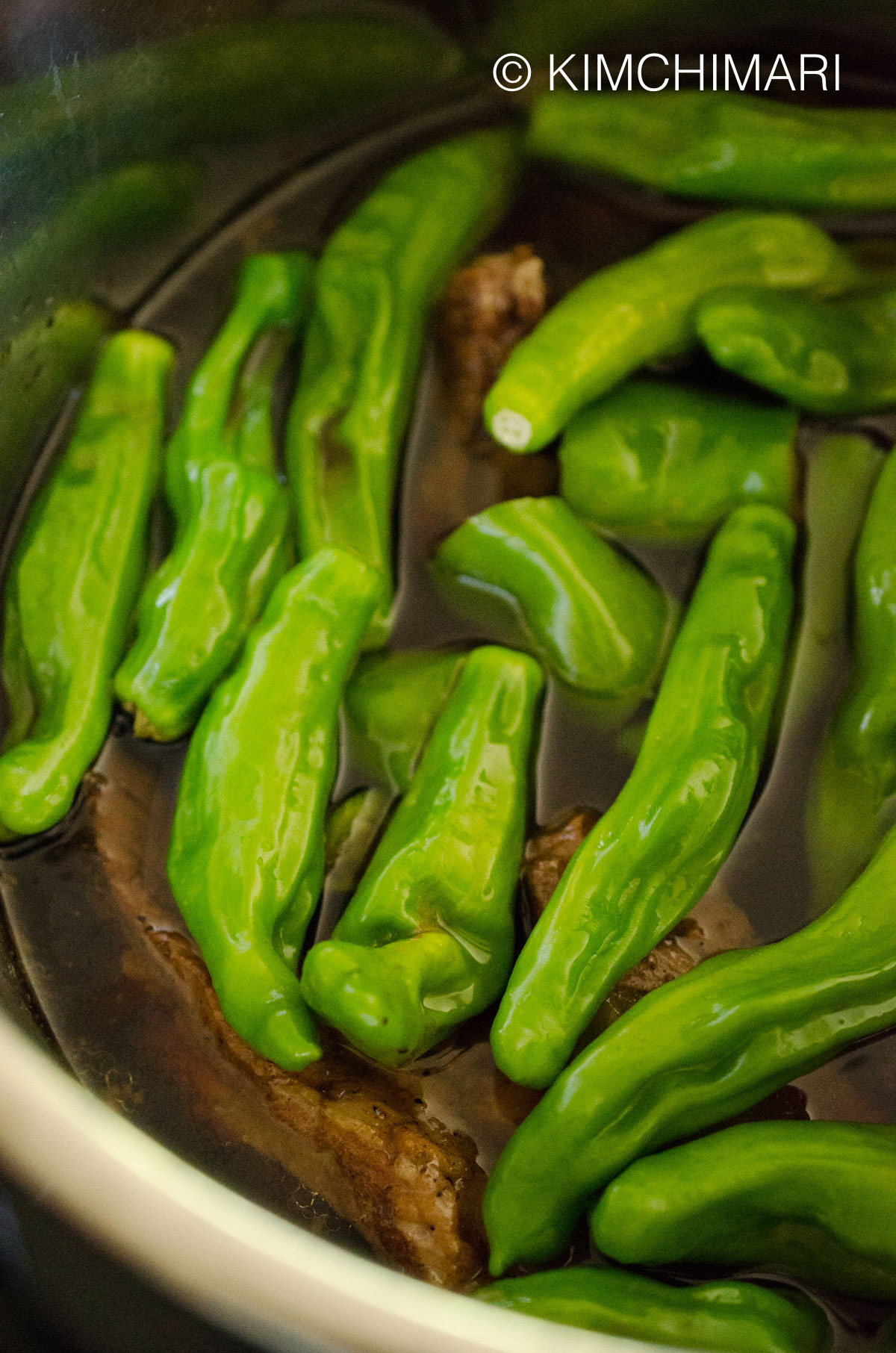
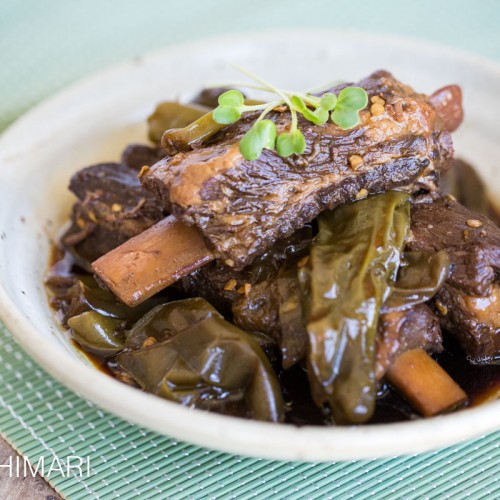
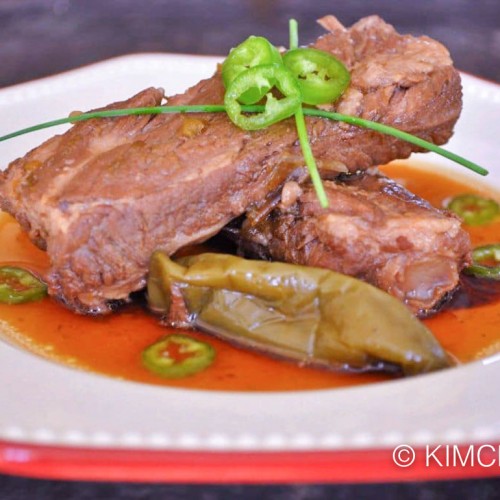
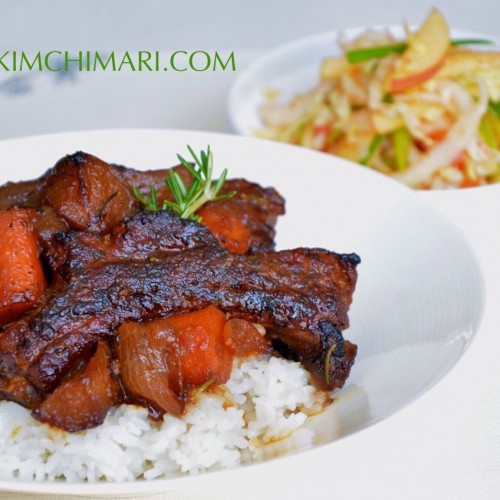
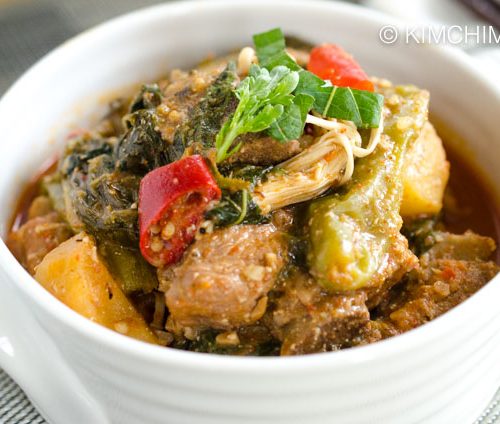
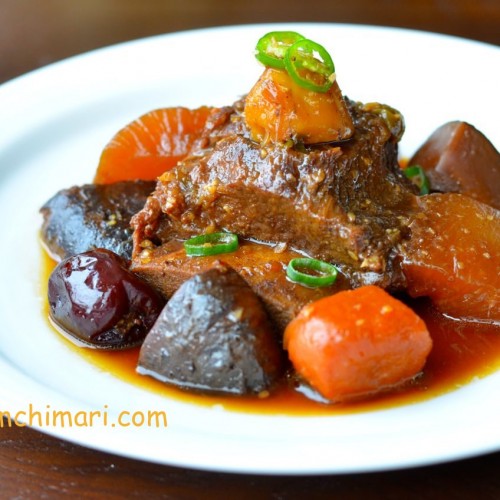
















I did this recipe with beef since I don’t eat pork. thanks for the recipe.
That’s a good option! Thanks for letting me know.
I love your recipes too, and have 3 shishito peppers growing in my terrace just waiting to turn into this. Buying a pot in pot cooker on sale to make this with rice (and with seitan rather than pork) in the IP. Thanks so much!
Oh wonderful!!! My shishito pepper plants are all done for the year. I hope you like it as much as I do.
I meant to add the rating in my last comment. My apologies!
So kind! Thank you!
I’ve made this 3 times since Christmas when I first discovered this recipe, and plan to make it again tonight! I don’t have an Instapot so I make it in my Cuckoo rice cooker instead. The only modifications I make are: I use 2/3 the amount of salt to try to reduce sodium intake (still tastes delicious!) and add some Dangmyun (Korean vermicelli noodles) to the sauce. Thank you for sharing the recipe for this delicious dish!
Oh yes, if you are going to eat noodles with it, the sauce will be way too salty. It’s not really meant for that so smart of you to reduce the soy sauce amount. Thank you so much for sharing!
I love your recipes. I enjoy reading and learning much from yoi
Thank you so much!! I’m so happy to hear that.